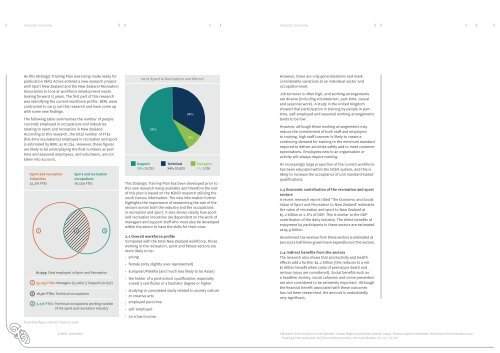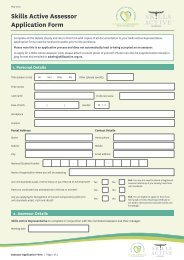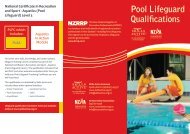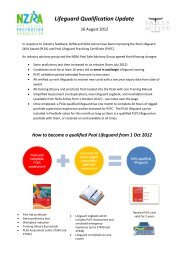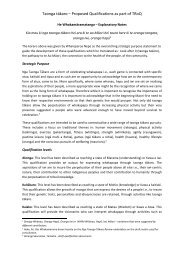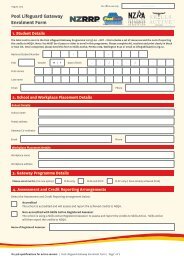Skills Active Aotearoa Sector Strategic Training Plan 2012-2015
Skills Active Aotearoa Sector Strategic Training Plan 2012-2015
Skills Active Aotearoa Sector Strategic Training Plan 2012-2015
Create successful ePaper yourself
Turn your PDF publications into a flip-book with our unique Google optimized e-Paper software.
industry overview8 industry overview9As this <strong>Strategic</strong> <strong>Training</strong> <strong>Plan</strong> was being made ready forpublication <strong>Skills</strong> <strong>Active</strong> entered a new research projectwith Sport New Zealand and the New Zealand RecreationAssociation to look at workforce development needslooking forward 15 years. The first part of this researchwas identifying the current workforce profile. BERL werecontracted to carry out this research and have come upwith some new findings.The following table summarises the number of peoplecurrently employed in occupations and industriesrelating to sport and recreation in New Zealand.According to this research, the total number of FTEs(full-time equivalents) employed in recreation and sportis estimated by BERL as 61,734. However, these figuresare likely to be underplaying the final numbers as parttimeand seasonal employees, and volunteers, are nottaken into account.Sport and recreationindustries52,216 FTEsSport and recreationoccupations26,509 FTEs61,734: Total employed in Sport and Recreation35,255 FTEs: Managers (13,062) // Support (21,637)16,911 FTEs: Technical occupations9,518 FTEs: Technical occupations working outsideof the sport and recreation industryIllustrative figure only Not drawn to scale2010 Sport & Recreation workforce †58%Support58% 35,753This <strong>Strategic</strong> <strong>Training</strong> <strong>Plan</strong> has been developed prior tothis new research being available and therefore the restof this plan is based on the NZIER research utilising the2006 Census information. The new information furtherhighlights the importance of researching the size of thesectors across both the industry and the occupationsin recreation and sport. It also shows clearly how sportand recreation industries are dependent on the work ofmanagers and support staff who must also be developedwithin the sector to have the skills for their roles.2.2 Overall workforce profileCompared with the total New Zealand workforce, thoseworking in the recreation, sport and fitness sectors aremore likely to be:• young• female (only slightly over-represented)• European/Pakēhā (and much less likely to be Asian)• the holder of a post-school qualification, especiallya level 3 certificate or a bachelor degree or higher• studying or completed study related to society cultureor creative arts• employed part-time• self-employed• on a low income.Technical34% 20,80534%8%Managers8% 5,176However, these are only generalisations and maskconsiderable variations at an individual sector andoccupation level.Job turnover is often high, and working arrangementsare diverse (including volunteerism, part-time, casualand seasonal work). A study in the United Kingdomshowed that participation in training by people in parttime,self-employed and seasonal working arrangementstends to be low 1 .However, although these working arrangements mayreduce the commitment of both staff and employersto training, high staff turnover is likely to create acontinuing demand for training to the minimum standardrequired to deliver activities safely and to meet customerexpectations. Employees new to an organisation oractivity will always require training.An increasingly large proportion of the current workforcehas been educated within the NCEA system, and this islikely to increase the acceptance of unit standard-basedqualifications.2.3 Economic contribution of the recreation and sportsectorsA recent research report titled ‘The Economic and SocialValue of Sport and Recreation to New Zealand’ estimatesthe value of recreation and sport to New Zealand at$5.2 billion or 2.8% of GDP. This is similar to the GDPcontribution of the dairy industry. The direct benefits ofenjoyment by participants in these sectors are estimatedat $5.9 billion.Government tax revenue from these sectors is estimated attwo and a half times government expenditure in the sectors.2.4 Indirect benefits from the sectorsThe research also shows that productivity and healtheffects add a further $4.2 billion (this reduces to a net$1 billion benefit when costs of premature death andserious injury are considered). Social benefits such asa healthier society, social cohesion and crime preventionare also considered to be extremely important. Althoughthe financial benefit associated with these outcomeshas not been researched, the amount is undoubtedlyvery significant.† (BERL estimates)1 Blundell, Richard and Lorraine Dearden, Costas Meghir and Barbara Sianesi (1999), Human Capital Investment: the Returns from Education and<strong>Training</strong> to the Individual, the Firm and the Economy. UK Fiscal Studies, 20, (1), 1-23, UK


